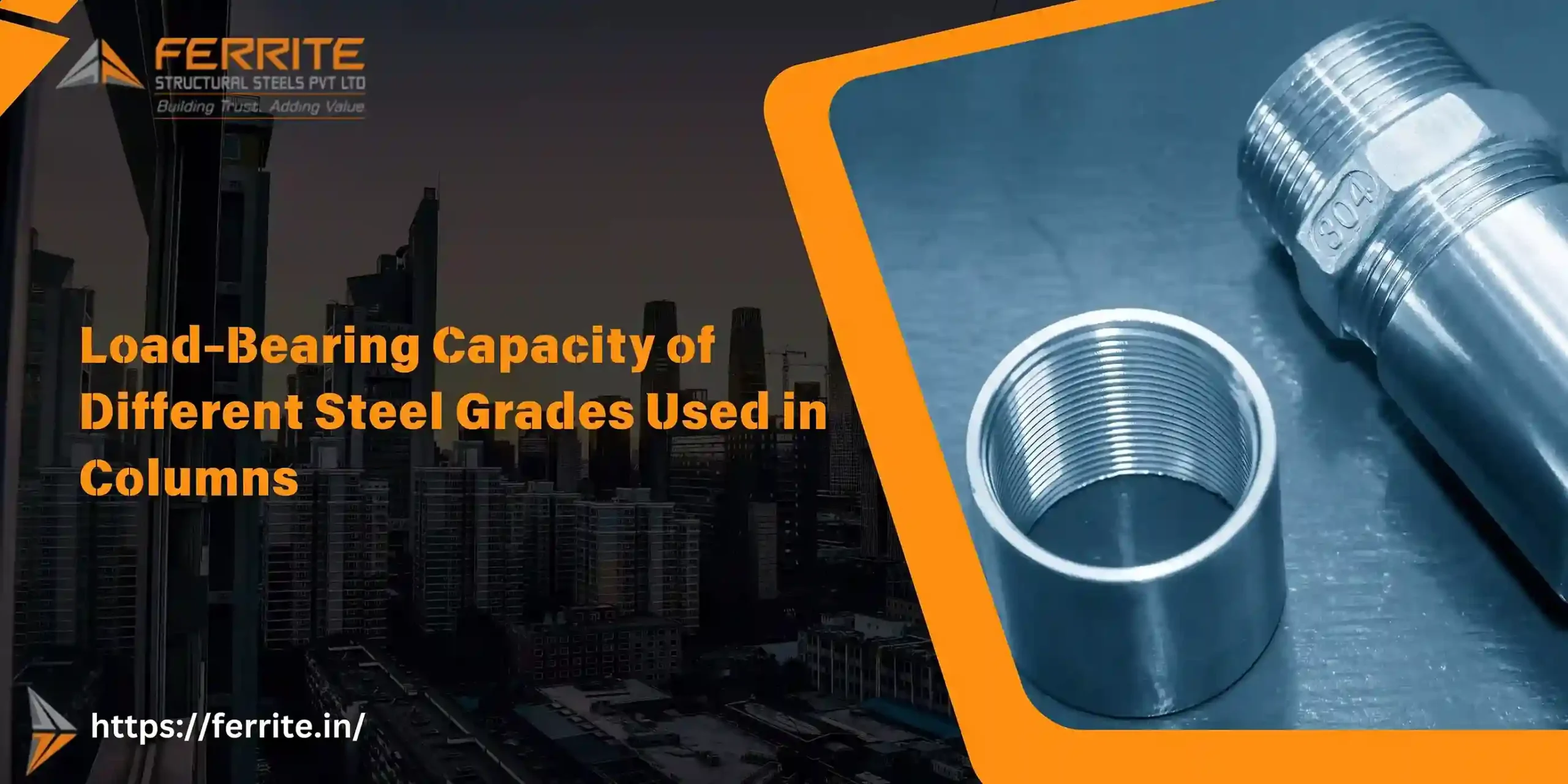In modern construction, steel columns play a critical role in supporting the structural framework of buildings, bridges, and industrial projects. Their strength, ductility, and durability make steel one of the most reliable materials for bearing heavy loads. However, not all steel is created equal. The load-bearing capacity of steel columns largely depends on the grade of steel used — each grade offers distinct mechanical properties that influence performance under compression and load.
Understanding the relationship between steel grades and load-bearing capacity is vital for engineers, architects, and contractors who aim to design safe and long-lasting structures. In this blog, we will explore the different steel grades used in columns, their mechanical properties, and how these grades influence load-bearing capacity.
What Is Load-Bearing Capacity in Steel Columns?
The load-bearing capacity refers to the maximum load a steel column can safely carry before failure or deformation. It depends on several factors, including:
- The cross-sectional area of the column
- The grade and quality of steel
- The length and slenderness ratio of the column
- The type of load (axial, eccentric, or bending)
- The support conditions (fixed, pinned, or free ends)
Among these, the steel grade is a decisive factor because it determines the yield strength and tensile strength of the material — two key properties that directly affect how much load a column can support without permanent deformation.
Understanding Steel Grades and Their Mechanical Properties
Steel grades are classified based on their chemical composition and mechanical strength. In India and globally, common structural steel grades include IS 2062, EN 10025, and ASTM standards, each specifying the yield and tensile strength required for construction.
Here’s a brief overview of the most commonly used structural steel grades for columns:
| Steel Grade | Yield Strength (MPa) | Tensile Strength (MPa) | Common Applications |
|---|---|---|---|
| IS 2062 E250 | 250 | 410–540 | Residential and light industrial structures |
| IS 2062 E350 | 350 | 490–640 | Commercial and heavy industrial buildings |
| IS 2062 E450 | 450 | 570–720 | High-rise buildings, bridges, heavy structures |
| EN 10025 S275 | 275 | 410–560 | General construction and columns |
| EN 10025 S355 | 355 | 490–630 | Bridges, offshore structures, heavy columns |
| ASTM A36 | 250 | 400–550 | General structural applications |
| ASTM A572 Grade 50 | 345 | 450–620 | High-strength applications, tall columns |
Load-Bearing Capacity Comparison of Different Steel Grades
1. IS 2062 E250 Steel Columns
The IS 2062 E250 grade is one of the most widely used steels in India for general-purpose structural applications. With a yield strength of 250 MPa, it is suitable for columns in low to medium-rise buildings where moderate load requirements are expected.
Advantages:
- Cost-effective
- Easy to fabricate and weld
- Readily available
Limitations:
- Not suitable for heavy load or high-rise structures
- Limited tensile strength compared to higher grades
Typical Load-Bearing Capacity:
A column made of E250 steel can typically support around 150–250 kN, depending on its dimensions and design factors.
2. IS 2062 E350 Steel Columns
For applications requiring higher strength, IS 2062 E350 offers a significant improvement in yield strength (350 MPa). It’s ideal for industrial sheds, warehouses, and mid-rise buildings.
Advantages:
- Higher yield strength ensures greater load-carrying ability
- Better resistance to deformation under compression
- Excellent weldability and toughness
Typical Load-Bearing Capacity:
Columns of this grade can bear loads of approximately 250–400 kN, depending on size and geometry.
3. IS 2062 E450 Steel Columns
E450 steel belongs to the high-strength category, capable of withstanding heavy loads and extreme stress conditions. It is used in high-rise buildings, bridges, power plants, and industrial complexes.
Advantages:
- Exceptional strength and rigidity
- Suitable for large-span and tall structures
- Reduces the weight of steel required per structure
Typical Load-Bearing Capacity:
Depending on dimensions, E450 steel columns can safely carry 400–600 kN or more.
4. EN 10025 S355 Structural Steel Columns
The S355 grade (equivalent to IS 2062 E350) is popular in European standards and is known for its balance of strength, ductility, and weldability. It is used in bridges, towers, and heavy columns.
Advantages:
- High structural integrity
- Good fatigue resistance
- Excellent for complex structures
Typical Load-Bearing Capacity:
A column made from S355 steel can typically handle 300–500 kN depending on design conditions.
5. ASTM A572 Grade 50 Steel Columns
This high-strength, low-alloy steel grade is widely used in international construction standards. It offers a yield strength of 345 MPa, making it suitable for heavy load-bearing columns and long-span structures.
Advantages:
- High load capacity
- Superior toughness and weldability
- Excellent performance under dynamic loads
Typical Load-Bearing Capacity:
Depending on geometry, A572 Grade 50 columns can handle 350–550 kN.
Factors Affecting the Load-Bearing Capacity of Steel Columns
While steel grade plays a major role, the load-bearing performance of columns also depends on the following design and environmental factors:
- Column Length and Slenderness Ratio
Short, stocky columns can bear higher loads than slender columns due to lower chances of buckling. - Cross-Sectional Shape
Hollow structural sections (HSS) and I-sections can enhance the load-carrying capacity due to their geometry and distribution of stress. - Column End Conditions
Fixed-end columns have higher load capacity compared to pinned or free-end columns. - Welding and Fabrication Quality
Poor welding or misalignment can reduce the effective strength of the column. - Corrosion Protection
Corrosion decreases the cross-sectional area over time, reducing load capacity. Using galvanized steel or proper coatings ensures longevity.
Why Choosing the Right Steel Grade Matters
Selecting the appropriate steel grade for columns is not just about strength—it’s about achieving the perfect balance between safety, cost, and performance.
- For small buildings: IS 2062 E250 is often sufficient.
- For medium projects: E350 or EN S275 offers better reliability.
- For heavy or high-rise structures: E450, S355, or ASTM A572 are ideal.
Using a higher-grade steel not only improves load-bearing efficiency but also reduces material weight, leading to cost savings in foundations and structural reinforcements.
Ensuring Quality and Compliance
Always source steel from a certified steel supplier in India who provides material with proper mill test certificates (MTC) and IS/EN/ASTM compliance. Quality-assured steel ensures consistent performance, durability, and safety during construction.
If you’re planning a project that demands strong and reliable steel columns, partner with reputed suppliers like Ferrite Structural Steels Pvt Ltd, known for delivering premium-grade structural steel across India. With a wide range of steel grades and quality assurance, Ferrite ensures your construction stands the test of time.
Conclusion
The load-bearing capacity of steel columns is deeply influenced by the steel grade, as each grade defines specific yield and tensile strengths. From IS 2062 E250 used in light structures to E450 and S355 for high-rise projects, choosing the right grade is critical for ensuring structural stability, safety, and efficiency.
By understanding the relationship between steel grades and load performance, engineers can design safer, cost-effective, and more durable structures — ensuring the backbone of modern architecture remains strong and resilient for decades.







